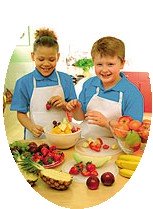|
Kids and High Fiber FoodsKids need fiber too! High fiber foods are not just for the baby boomer crowd. But if you offer a bran muffin or a cup of lentil soup to a kid, you're likely to get groans and sneers. Not to worry. There is an amazing array 
of delicious high fiber foods that your kid has eaten (probably even today) without their realizing that it was actually good for them. Today's children are growing overweight at an alarming rate. Part of the problem is that children just don't eat enough fiber. Obesity is uncommon in countries with high-fiber diets. Foods that are high in fiber are smart and caring choices for your kids because they're filling and discourage overeating - and fiber itself has no calories. It's just as important to your child's health as it is to yours to get enough fiber. An easy way to calculate how much fiber your kid should have every day is by adding 5 to your kid's age. For example, if you have a 6-year-old, he or she should get about 11 grams of daily fiber. Adults and those older than 15 need 25 to 30 grams of fiber per day. In the skins of fruits and vegetables and the husks of grain are insoluble fibers which act like a sponge, absorbing water into the stools helping regularity. These soft and bulky stools are typical for people with high fiber diets, and very important for kids in preventing constipation and promoting regularity. Fiber also helps delay the absorption of sugars into the bloodstream, regulating blood sugar levels which help kids learn and behave better. It also reduces the risk for some cancers later in life. Plus, drinking lots of fluids (4 cups more liquids for preschoolers, 6-8 cups additional liquids for older school age kids) while eating high fiber foods moves the food through the digestive system quicker helping to rid the body of toxins and waste. "Teens whose diets were rich in fiber and low in total fat consumed more vitamins and minerals and less total cholesterol and saturated fat than their peers," said Dr. Theresa Nicklas, a nutritionist with the USDA/ARS Children's Nutrition Research Center at Baylor College of Medicine Whatever you do to get more fiber into your kid's diet, make sure you do it gradually. Consider changes in meals and snacks that will add high fiber to the diet over a span of time. Offer a wide variety of high fiber food sources. There are so many fun and inventive ways to introduce foods that are high in fiber to your kid's diet. Use dried fruits like cranberries and raisins in cookie dough or muffin batter. Add refried beans to taco meat. Cut up celery and carrot sticks and dip them in peanut butter or salsa. Sprinkle sunflower or sesame seeds on salads. Kids tend to be most receptive to the fiber found in fruits, vegetables and presweetened breakfast cereals. Apricots, figs and prunes make wonderful high fiber snacks. Kids love to crack open nuts like peanuts and pistachios. Choose pears, apples and berries; peas, nuts and beans; and cereals and pancakes made with whole grain. Whole grain foods include all parts of the grain. Finding foods made with the whole grain is easy to tell by checking out the ingredient list. The primary ingredient should read "whole grain" or "whole" as in whole wheat. If bread is brown in color, it doesn't mean that it is whole grain. Get your kids to help make decisions about better eating, you might find their attitudes more open to a healthier diet plan. If you change slowly to more high fiber fruits and veggies, your kids' fiber adaptation should be smooth and seamless. Educate them early about high fiber foods and have them help make the meal so they will be more likely to pile it on their plate. Let them eat the "junk food" now and then, but make sure they eat the healthy stuff too. There's bound to be some protest, but if you set the example and show them the benefits, they will learn to make smart high fiber choices on their own. Childhood is the best time to set the stage for a lifetime of healthful eating habits. High fiber foods are a gift of love.
|
